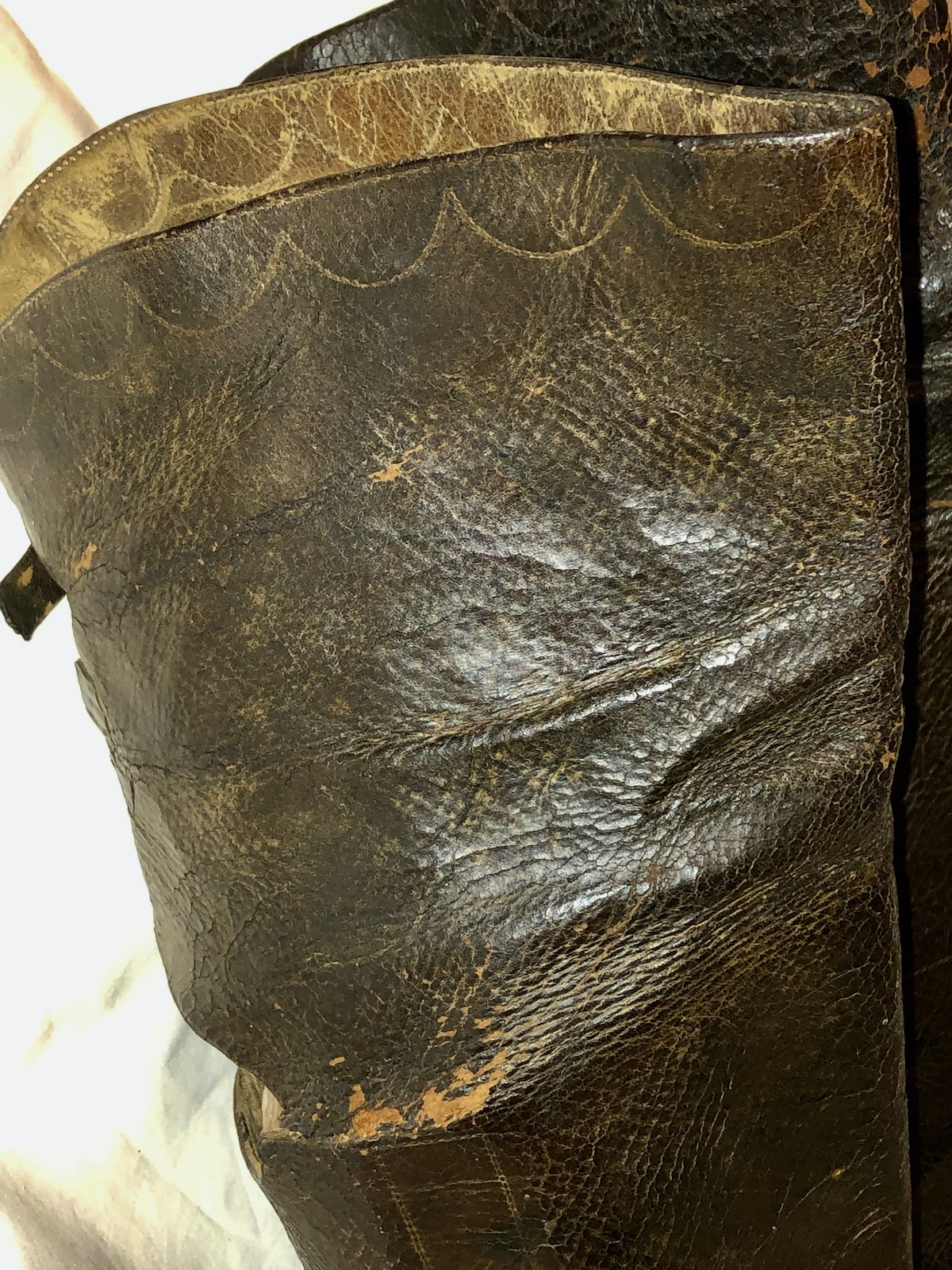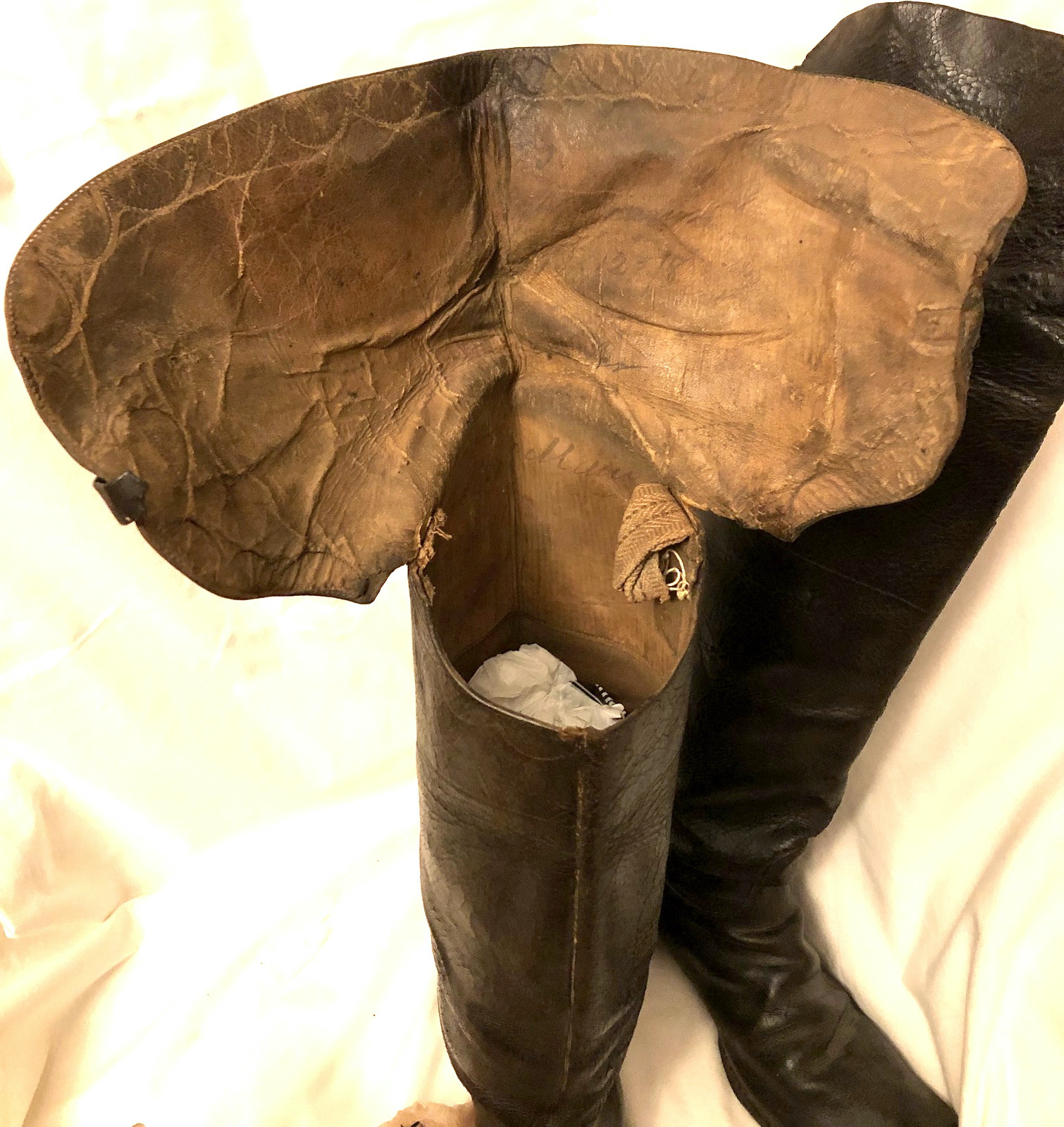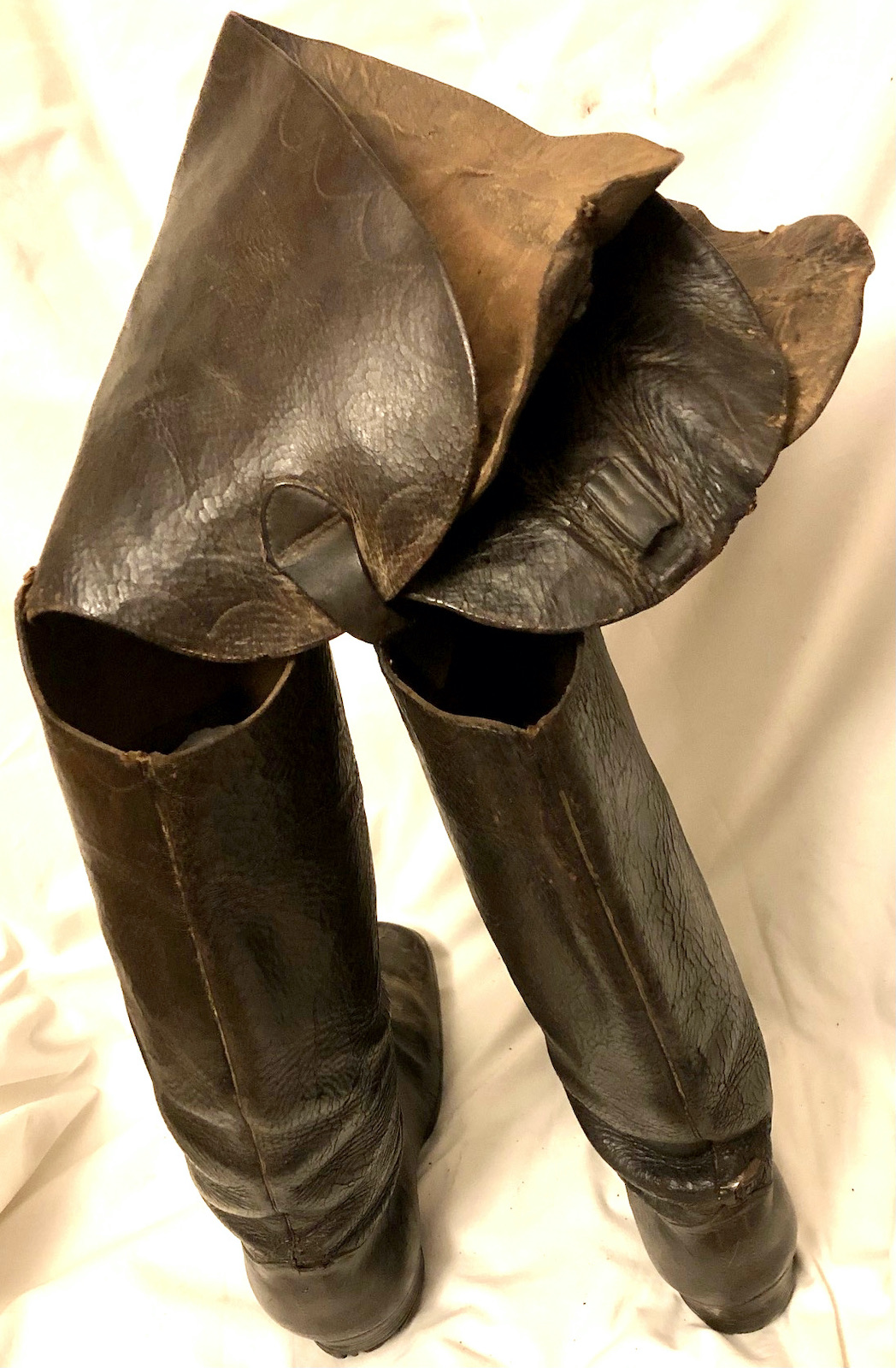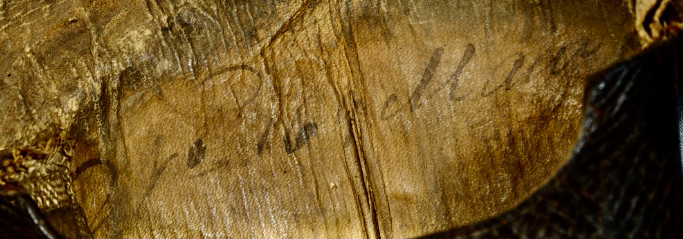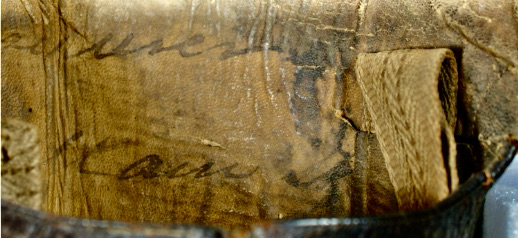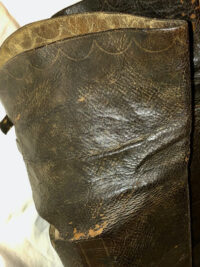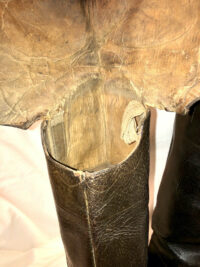Superior Quality Tall Civil War Officer’s Boots Worn by Gen. Seth Williams
SOLD
Superior Quality Tall Civil War Officer’s Boots Worn by Gen. Seth Williams – This pair of boots would have been considered high quality boots purchased by an upper echelon officer; they are constructed, in the Napoleonic style, of soft, tooled, pebble-grain, brown calfskin and lined with a thin, light brown pigskin. The interior pulls are heavy fabric; the boots are quite tall and would have extended above the wearer’s knees and exhibit wing-like projections, at the tops of the boots, which would have buckled behind the wearer’s lower thighs. Both stacked heels are affixed to the soles via cut nails; the soles are affixed via a combination of wooden pegs and sewing. The toe boxes are square, like most of the Civil War period boots. The boots exhibit field wear, but are in overall very good condition, with some slight tearing in the upper areas. There is considerable writing, in ink, in the interiors of the upper halves of both boots. We had our art conservator utilize UV and IR photography to “illuminate” exactly what the writing stated, in light of the fact that when we received the boots, we were informed that they had been the pair worn by Gen. Seth Williams, aide-de-camp and adjutant to Generals McClellan and Grant (Williams was responsible for delivering Grant’s poignant message, on April 7, 1865, to Gen. R.E. Lee, imploring the surrender of Lee’s army to prevent the “further effusion of blood”, as well as assisting Gen. Grant in drafting the surrender terms, delivered at the McLean House, on April 9, 1865). We have included in this listing, the various images produced by the conservator – they indicate that the interior of the boots do display the name “Williams”, perhaps “Seth” and the word “Major” – Williams entered the service, at the onset of the war, at the rank of Major and was breveted to the rank of Major General, at the end of the war. Although we have had numerous pairs of war period boots, this pair, just based upon their quality of construction and height, are far more impressive; in addition, their wartime ownership by a General with such a distinguished record, makes them historically significant.
Measurements: Height – 23“; Length (from heel to toe) – 10“
| MAJ. GEN. SETH WILLIAMS, U.S. ARMY
1822-1866 Born March 22, 1822, in Augusta, Maine, Gen. Seth Williams was a member of the class of 1842 at the U.S. Military Academy at West Point. He served with honor and gallantry during the Mexican War. During the Civil War he participated in the campaigns at Gettysburg and with the Army of the Potomac. Assigned to the staff of Gen. Ulysses S. Grant, he was among those present at Appomattox Court House April 9, 1865, to witness the signing of the papers that brought an end to hostilities between North and South. Gen. Williams had just been assigned to duty as adjutant for the Military Division of the Atlantic, when he was taken ill. He died five weeks later, one day after his 44th birthday. He is buried next to his parents in Augusta, Maine.
|
Seth Williams
Born: March 22, 1822
Birthplace: Augusta, Maine
Father: Daniel Williams 1795 – 1870
Mother: Mary Sawtelle 1798 – 1827
Wife: Maria Williams 1824 – 1893
Children:
William H. Williams 1850 – 1923
(Buried: Forest Grove Cemetery, Augusta, Maine)
Education:
1842: Graduated from West Point Military Academy – (23rd in class)
Occupation before War:
1842 – 1844: Brevet 2nd Lt. United States Army, 2nd Artillery
1842 – 1843: Garrison Duty at Fort Adams, Rhode Island
1844 – 1847: 2nd Lt. United States Army, 3rd Artillery
1847 – 1855: 1st Lt. United States Army, 1st Artillery
1846 – 1848: Aide on General Patterson’s Staff
1847: Brevetted Captain for Gallantry at Battle of Cerro Gordo, Mexico
1850 – 1853: Adjutant at West Point Military Academy
1853 – 1861: Brevet Captain in the United States Army
1853: Assistant Adjutant General, U.S. Army, Division at Troy, New York
1853 – 1860: Served as U.S. Army Adjutant General office in D.C.
1860 – 1861: Assistant Adjutant General, U.S. Army Dept. of the West
1861: Brevet Major and Assistant Adjutant General for U.S. Army
1861: Assistant Adjutant General for U.S. Army Dept. of Ohio
Civil War Career:
1861 – 1862: Major and Assistant Adjutant General, U.S. Army
1861 – 1862: Assistant Adjutant, General in the Union Army
1861 – 1866: Brigadier General, Union Army Volunteers
1861 – 1862: Served in Washington, D.C.
1862 – 1864: Inspector General in the Adjutant General’s Dept.
1862: Served in the Virginia Peninsula Campaign
1862 – 1866: Lt. Colonel and Assistant Adjutant General for U.S. Army
1862: Served in the Maryland Campaign
1862 – 1863: Served in the Rappahannock Campaign in Virginia
1863: Brevetted Colonel for Gallantry at Battle of Gettysburg, Pennsylvania
1864 – 1866: Acting Inspector General on Staff of General in Chief
1864: Brevetted Major General for his duty in the War in two battles
1865: Brevetted Brig. General in U.S. Army for Gallantry at Surrender
1865: Brevetted Major General in U.S. Army for his duty in the war
1866: Adjutant General for U.S. Army Military Division of the Atlantic
1866: Sick with inflammation of the brain went to his sister’s house
Died: March 23, 1866
Place of Death: Boston, Massachusetts
Cause of Death: Inflammation of the brain
Age at time of Death: 44 years old
Burial Place: Forest Grove Cemetery, Augusta, Maine
| Seth Williams | |
| Brevet Maj. Gen. Seth Williams | |
| Born | March 22, 1822 Augusta, Maine |
| Died | March 23, 1866 (aged 44) Boston, Massachusetts |
| Place of burial | Forest Grove Cemetery, Augusta, Maine |
| Allegiance | United States of America Union |
| Service/branch | United States Army Union Army |
| Years of service | 1842–1866 |
| Rank | Brigadier General Brevet Major General |
| Battles/wars | American Civil War |
Seth Williams (March 22, 1822 – March 23, 1866) was an American military officer who served as assistant adjutant general of the Union‘s Army of the Potomac during the American Civil War.
Early life
Williams was born in Augusta, Maine. He graduated from the United States Military Academy in 1842, 23rd in a class of 56. He served as aide-de-camp to General Robert Patterson in the Mexican–American War with the rank of second lieutenant. Williams received a brevet to the rank of captain for his conduct at the Battle of Cerro Gordo as a first lieutenant. He was adjutant at West Point from 1850 to 1853 before moving to the adjutant general‘s office in Washington, D.C.
Civil War
Williams was promoted to the rank of major in August 1861 and lieutenant colonel on July 7, 1862. On September 28, 1861, President Abraham Lincoln appointed Williams a brigadier general of volunteers, to rank from September 23, 1861.[1] President Lincoln nominated Williams for the promotion on December 21, 1861 and the U.S. Senate confirmed the appointment on July 17, 1862.[1] He was a groomsman at George McClellan’s wedding in New York City on May 22, 1860.[2]
Seth Williams served as assistant adjutant general to Major General George B. McClellan in the Department of the Ohio in the summer of 1861.[3] From August 20, 1861 to March 1864, Williams was assistant adjutant general of the Army of the Potomac, responsible for the routine drafting of orders, correspondence, and reports. McClellan named him to that position after unsuccessfully requesting the assignment to Maj. Gen. Fitz John Porter.[4] McClellan and Williams became friends during their service together. Williams was called before the United States Congress Joint Committee on the Conduct of the War to testify about the Battle of Gettysburg. Williams’s testimony was especially helpful to Meade.[5]
Williams was a convivial officer to whose quarters other officers resorted for company. Due to this, he was often called “The nicest man in the army.”
Williams later served as inspector general on the staff of Lt. Gen. Ulysses S. Grant from the spring of 1864 to February 9, 1866. When Grant decided to recommend surrender to Robert E. Lee during the Appomattox Campaign, it was Williams who took the message to the Confederate lines. He also delivered Grant’s terms to the Confederate army. He was present at the surrender on April 9, 1865.
Williams was awarded the brevet of colonel for the Battle of Gettysburg. On January 13, 1866, President Andrew Johnson nominated Williams for the brevet grade of major general of volunteers for his service in 1863 and 1864, to rank from March 13, 1865, and the U.S. Senate confirmed the nomination on March 12, 1866.[6] Although slated to begin service as assistant adjutant general of the Military Division of the Atlantic, Williams became ill later that month and left for Boston, Massachusetts. There he died of a brain ailment, described as an “inflammation” on March 23, 1866.[1][7] He was buried in Augusta’s Forrest Grove Cemetery. Fort Williams on Cape Elizabeth, Maine, is named for him. The name was assigned on April 13, 1899. On April 10, 1866, President Andrew Johnson nominated Williams posthumously for appointment to the brevet grade of brigadier general in the regular army, to rank from March 13, 1865 and the U.S. Senate confirmed the appointment on May 4, 1866.[8] On July 17, 1866, President Johnson nominated Williams posthumously for appointment to the brevet grade of major general in the regular army, to rank from March 13, 1865 and the U.S. Senate confirmed the appointment on July 23, 1866.
Seth Williams Famous memorial
BIRTH
22 Mar 1822
Augusta, Kennebec County, Maine, USA
DEATH
22 Mar 1866 (aged 44)
Boston, Suffolk County, Massachusetts, USA
BURIAL
Augusta, Kennebec County, Maine, USA
Civil War Union Brigadier General. Born in Augusta, Maine, he graduated from the United States Military Academy at West Point, New York in 1842 and was commissioned a 2nd Lieutenant. He served as an aide-de-camp to Major General Robert Patterson and for his actions during the Mexican-American War, was promoted a Captain. At the start of the Civil War, he was named as the Assistant Adjutant General for the Department of the Ohio and was promoted to Major. In 1862, he was promoted Lieutenant Colonel and was named as the Assistant Adjutant General for the Army of the Potomac, commanded by General George McClellan. For his service at the Battle of Gettysburg he was promoted Colonel. In March 1864, he was named as an Inspector General on the staff of Lieutenant General Ulysses S. Grant and when Confederate General Robert E. Lee surrendered on April 9, 1865, it was Williams who drafted the surrender documents. He was also present at the surrender and for his war service was brevetted Major General in the Regular Army on March 13, 1865. After the Civil War, Williams was named as Assistant Adjutant General of the Military Division of the Atlantic, but fell ill from what was described as a brain ailment and died one day after his 44th birthday in Boston, Massachusetts.





